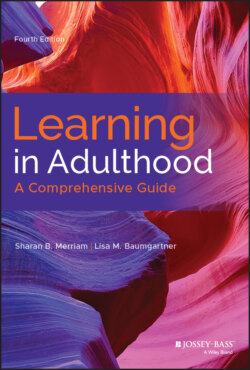Читать книгу Learning in Adulthood - Sharan B. Merriam - Страница 12
Part I Adult Learning in Contemporary Society
ОглавлениеIt is very much the perspective of this book that learning is a personal process—but a process that is shaped by the context of adult life and the society in which one lives. Compare how industrialization of the early years of the twentieth century affected what an adult needed and wanted to learn with the knowledge economy of the early twenty-first century. This learning in turn affects the social context. For example, as we become more technologically savvy, businesses respond by developing more sophisticated systems and gadgets that then require us to keep learning. It is indeed an interactive process between the learner and the social context. The four chapters in Part I explore the current sociocultural context, the range of learning opportunities available to adults in this context, and who takes advantage of these opportunities and why.
Chapter 1 describes three factors characteristic of American society today that affect what adults want to learn. First, dramatic changes are occurring in the demographic base of our society. Adults outnumber those under 18 years old for the first time ever. Moreover, the percentage of the population over age 65 continues to grow, commanding the attention of policymakers, businesspeople, and educators alike. Our population as a whole is also better educated than ever before, and there is more cultural and ethnic diversity. Therefore, there are simply more adults seeking learning opportunities, as well as more groups of adults with particular learning needs.
The second and third factors shaping the learning enterprise are globalization and technology. These are very much interrelated, of course; technology has had an enormous impact on the economy. Robotics and automation displace production workers but create other jobs; technology has fostered whole new work structures, such as job sharing and telecommuting. The effect of the global economy and technological advances on the nature of adult learning is staggering. Adults find that they must continue their learning past formal schooling in order to function at work, at home, and in their communities. The need for new knowledge, for updating old information, for retraining, has resulted in a multibillion-dollar educational enterprise.
Because of its ever-increasing presence in our lives, we have added a new chapter on technology and adult learning. From online courses offered by educational institutions and corporations to the myriad of online sites on the World-Wide Web to technological innovations that are pervading our everyday world, technology is both creating learning demands and facilitating learning in adult life. Chapter 2 is thus devoted to broadly examining the role of technology in the context of adult learning today. Some of the topics include the history of distance education, online learning theories, and the role of technology in informal and nonformal learning.
Some of this learning takes place in formal settings sponsored by countless institutions and agencies. As might be expected, business and industry and educational institutions offer many adult learning opportunities, but so do the military, cooperative extensions, churches, hospitals, and other institutions. Chapter 3 explores how the context of formal institutional settings influences the learner and the learning process. Also reviewed are learning opportunities that are nonformal, such as those offered by community-based agencies such as museums, libraries, hospitals, and so on, and informal, incidental, and self-directed opportunities, as might happen in the course of the workday or by looking up something on the Internet. In addition, we briefly discuss online learning, a fourth environment for learning that overlays formal, nonformal, and informal modes of learning. In the second half of this chapter, we explore the interrelated concepts, first, of organizational learning and the learning organization, and second, of lifelong learning and the learning society.
Chapter 4 profiles who participates in adult learning, why adults participate, and what an adult chooses to learn. Most of this information on participation and motivation is in reference to formal learning, such as that provided by educational institutions and employers. Estimates of the percentage of the adult population that participates in learning have steadily risen over the past 50 years, with the most current study suggesting that approximately 44% of all adult Americans participate in learning. Studies of self-directed learning and other nonformal types of education reveal the percentage of participation to be even higher. Clearly, learning is an important activity for today's adults. What motivates adults to participate and what deters participation is important information, especially for program developers. This chapter also reviews motivational studies.
The final section of Chapter 4 “problematizes” the concept of participation. By examining the assumptions that underlie participation we squarely confront the issues of access and opportunity in adult education. The gap between the better educated who seek out continuing education and those who do not continues to widen. Adult learning seems to have become a vehicle for solidifying a socioeconomic structure that limits access and opportunity, contrary to the stated goal of equal access to education in our society. We examine the rhetoric, which espouses one set of values, and the reality, which demonstrates another, in the provision of adult learning opportunities.
